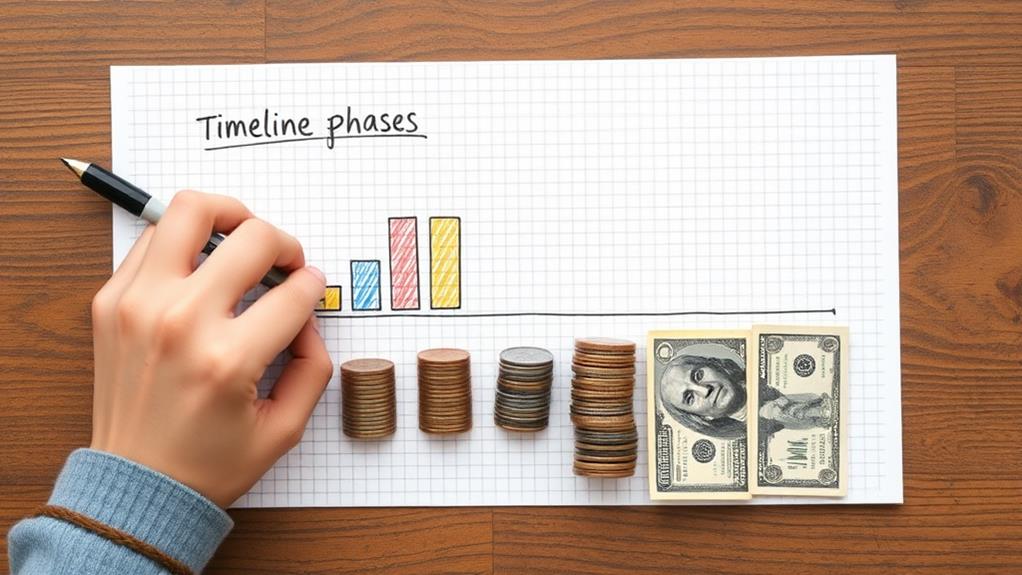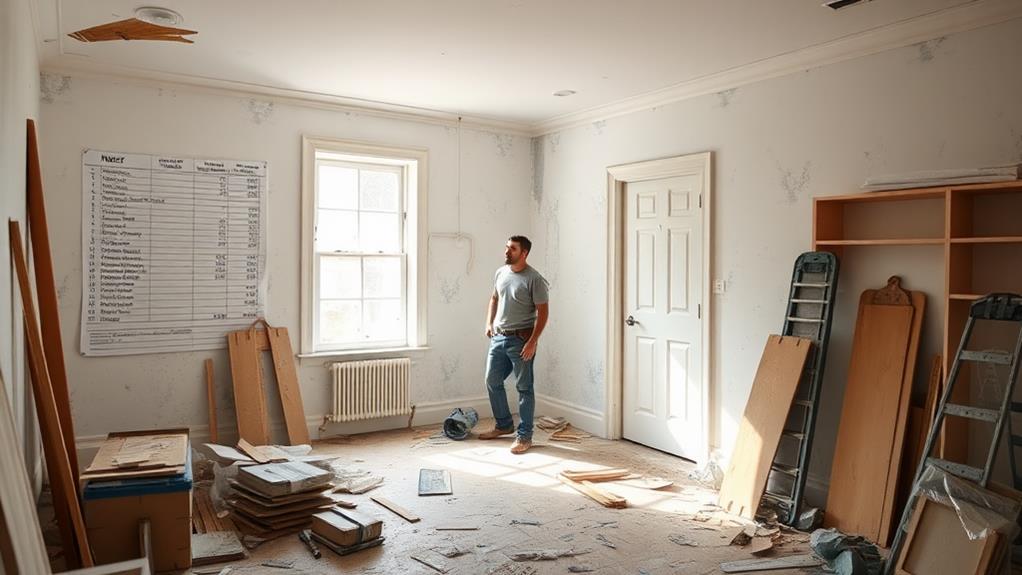Creating a realistic cash flow projection for your renovation involves several key steps. Start by thoroughly assessing the renovation scope and gathering detailed cost estimates from multiple sources. Develop a comprehensive project timeline, breaking down tasks and allocating appropriate timeframes. Calculate monthly expenses, factoring in both fixed and variable costs, and include a contingency buffer of 10-20%. Plan for potential setbacks and unexpected issues by setting aside additional funds. Regularly review and adjust your projection as the project progresses, comparing actual expenses to estimates. By following these steps, you'll be better prepared to manage your renovation's financial aspects effectively. Dive deeper to uncover more insights for a successful project.
Assess Your Renovation Scope

The foundation of any successful cash flow projection for a renovation project lies in a thorough assessment of the renovation scope. This critical first step involves a comprehensive evaluation of all aspects of the planned work, from structural changes to cosmetic updates.
Begin by creating a detailed list of every task and modification you intend to make, no matter how small. Consider factors such as room-by-room improvements, necessary permits, potential structural issues, and desired finishes.
Next, prioritize these tasks based on necessity and budget constraints. Distinguish between essential renovations and optional upgrades to help allocate funds more effectively. Consult with professionals such as contractors, architects, or designers to gain insight into potential challenges and realistic timelines for each aspect of the project. This expert input can help refine your scope and identify any overlooked elements.
Remember to account for contingencies and unexpected issues that may arise during the renovation process. By thoroughly assessing your renovation scope, you establish a solid foundation for accurate cost estimation and timeline planning, which are crucial components of a realistic cash flow projection for your renovation project.
Gather Cost Estimates
With a clear understanding of your renovation scope, the next logical step is to gather accurate cost estimates for each aspect of the project. Begin by researching local contractors, suppliers, and service providers who specialize in the specific areas of your renovation. Obtain multiple quotes for each component, including materials, labor, and any necessary permits or inspections.
When requesting estimates, provide detailed information about your project scope, desired materials, and any specific requirements. This will help ensure more accurate quotes and reduce the likelihood of unexpected costs later. Don't forget to factor in potential additional expenses such as waste removal, temporary accommodations if needed, and contingency funds for unforeseen issues.
Consider using online renovation cost calculators and industry-standard pricing guides to cross-reference the estimates you receive. This can help you identify any outliers or unrealistic quotes. Remember to account for regional variations in pricing and factor in any seasonal fluctuations that may affect costs. By gathering comprehensive and realistic cost estimates, you'll be better equipped to create an accurate cash flow projection for your renovation project.
Create a Project Timeline

Once cost estimates are in hand, developing a comprehensive project timeline becomes crucial for effective cash flow projection. This timeline should outline each phase of the renovation, from demolition to final touches, with specific start and end dates.
Begin by identifying major milestones and breaking them down into smaller tasks. Consider factors like permit acquisition, material delivery times, and potential delays due to unforeseen circumstances.
Collaborate with contractors to establish realistic timeframes for each task, taking into account their availability and workload. Sequence the tasks logically, noting any dependencies between different aspects of the project. For example, electrical work may need to be completed before drywall installation.
Allocate buffer time between phases to account for unexpected setbacks or variations in work pace. Use project management tools or software to visualize the timeline and track progress.
Regularly update the timeline as the project evolves, adjusting for any changes in scope or delays. This dynamic approach ensures that your cash flow projection remains accurate and aligned with the actual progress of the renovation, allowing for better financial planning and resource allocation throughout the project's duration.
Calculate Monthly Expenses
Following the creation of a detailed project timeline, attention must shift to calculating monthly expenses for the renovation. This step is crucial for maintaining accurate cash flow projections and ensuring the project remains financially viable throughout its duration.
Begin by listing all anticipated expenses, categorizing them into fixed and variable costs. Fixed costs may include permits, insurance, and equipment rentals, while variable costs typically encompass materials, labor, and utilities. Research current market prices for materials and labor rates to establish realistic estimates. Factor in potential price fluctuations and include a contingency buffer of 10-20% for unexpected costs.
Break down the expenses on a monthly basis, aligning them with the project timeline. This allows for a clear understanding of when specific costs will be incurred. Consider the payment terms for contractors and suppliers, as these can impact the timing of expenses. Additionally, account for any seasonal variations that may affect costs, such as higher energy bills during extreme weather conditions. By meticulously calculating and allocating monthly expenses, you create a solid foundation for an accurate cash flow projection, enabling better financial planning and management throughout the renovation process.
Plan for Contingencies

Despite meticulous planning, renovation projects often encounter unforeseen challenges that can impact both timeline and budget. To create a realistic cash flow projection, it's crucial to plan for contingencies. Experts recommend setting aside 10-20% of the total renovation budget as a contingency fund to cover unexpected expenses.
Common contingencies include hidden structural issues, such as water damage or outdated wiring, which may only be discovered once work begins. Delays due to weather, material shortages, or permit issues can also increase costs. Additionally, changes in project scope or design modifications during the renovation process may require additional funds.
When planning for contingencies, consider the age and condition of the property, as older buildings tend to have more hidden issues. Research local building codes and regulations to anticipate potential compliance costs. Consult with experienced contractors to identify potential risk areas specific to your project. Break down the contingency fund by project phase, allocating more to early stages where unforeseen issues are more likely to arise. Regularly review and adjust your contingency plan throughout the renovation process, reallocating funds as needed to ensure project completion within budget constraints.
Review and Adjust Regularly
A well-planned cash flow projection for renovation is not a static document but a dynamic tool that requires ongoing attention. Regular review and adjustment are essential to ensure the projection remains accurate and relevant throughout the renovation process. As the project progresses, unforeseen circumstances, changes in material costs, or timeline shifts may impact the cash flow.
Establish a routine for reviewing your cash flow projection, such as weekly or bi-weekly, depending on the project's complexity and duration. During these reviews, compare actual expenses and income against projected figures, identifying any discrepancies or trends. Update the projection with real-time data, adjusting future estimates based on current information and experiences.
Be prepared to make significant revisions if major changes occur, such as unexpected structural issues or design modifications. Regularly communicating with contractors, suppliers, and team members can help you stay informed about potential cash flow impacts. By consistently reviewing and adjusting your cash flow projection, you maintain a more accurate financial roadmap for your renovation project, allowing for better decision-making and resource allocation throughout the process.
Frequently Asked Questions
How Does a Renovation Impact Property Taxes?
A renovation can significantly impact property taxes by increasing the assessed value of your home. Improvements that enhance the property's market value, such as additions or major upgrades, may lead to higher property tax assessments and subsequent tax bills.
Should I Consider Refinancing My Mortgage to Fund the Renovation?
Refinancing your mortgage to fund a renovation can be a viable option. Consider factors such as current interest rates, your credit score, and the potential increase in property value. Consult a financial advisor to assess the best approach for your situation.
What Permits Are Typically Required for Home Renovations?
Home renovation permits typically include building, electrical, plumbing, and mechanical permits. Additional permits may be required for specific projects like structural modifications, zoning changes, or historical property alterations. Always check with your local building department for exact requirements.
How Can I Minimize Disruption to Daily Life During a Renovation?
To minimize disruption during renovations, consider temporary living arrangements, establish a dedicated work area, communicate regularly with contractors, plan for noise and dust control, and create a realistic timeline. Prioritize essential living spaces and maintain a flexible attitude throughout the process.
Are There Tax Incentives Available for Energy-Efficient Renovations?
Yes, tax incentives are often available for energy-efficient renovations. These may include federal tax credits, state rebates, and local incentives. Common eligible improvements include solar panels, energy-efficient windows, and high-efficiency HVAC systems. Consult a tax professional for specifics.
Conclusion
A realistic cash flow projection is crucial for successful renovation planning. While some may argue it's overly time-consuming, the benefits far outweigh the effort invested. By meticulously assessing scope, gathering estimates, creating timelines, calculating expenses, and planning for contingencies, homeowners can avoid financial pitfalls and ensure project completion. Regular review and adjustment of the projection throughout the renovation process further enhances its effectiveness. Ultimately, a well-crafted cash flow projection serves as a valuable roadmap, guiding renovators towards their desired outcome while maintaining fiscal responsibility.

